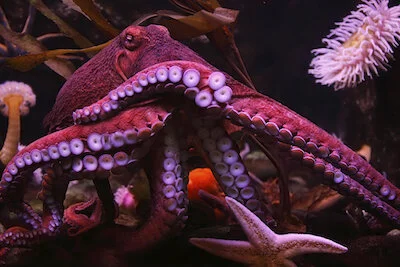An octopus has a head and eight legs with suckers.
Octopuses can change colour.
A squid has eight arms around its mouth.
Cuttlefish have a big head and tentacles.
They all have three hearts.
They squirt a cloud of black ink to escape.
A group of the large mollusc family are called cephalopods (say seff-luh-pod or keff-luh-pod).
Squid, octopus, cuttlefish and the nautilus are cephalopods. The word cephalopod means ‘head foot’ because of the way the legs are attached to the head. They all have three hearts and escape predators by expelling a cloud of black fluid known as ink. They move by jet propulsion: they force water rapidly out of their body, making the body shoot forward through the water.
This squid is called a bigfin squid, found in coral reefs. ©Getty
Squid
Squid have a very soft body with a large head and brain. They have three hearts.
There are about 300 different kinds of squid, but scientists believe there are more yet to be found.
The size depends on what species, or kind, of squid they are.
Squid breathe through gills so they do not have to come to the surface to breathe. There are eight arms around the mouth, two of which are longer and can contract, or tighten. Prey is caught and held by these two arms, and held by the other arms while the squid eats. The jaw of a squid is similar to a parrot’s beak, and it tears its prey apart. When escaping a predator, squid expel a cloud of black fluid known as ink, which makes it hard for the predator to see the squid.
There are five groups of squid:
Illustration: a giant squid in deep ocean. Photo©iStock
Giant squid
Giant squid grow to about 9 metres in length. They prefer cooler waters and swim between about 300 and 1,000 metres below the surface near Australia, Newfoundland, New Zealand and Norway.
Colossal squid
Colossal squid is the largest invertebrate of all, up to 14 metres long. It has sharp hooks at the end of the tentacles. It is found in just a few areas south of New Zealand, South America, Africa and in Antarctica.
Vampire squid
Vampire squid is about 30cm long. The tentacles are connected by a web of skin, which makes it look like it is wearing a black cloak, like a vampire. Its eyes look red or blue depending on the light around it. It is found in warm, tropical areas and keeps to deep water where it is dark.
Humboldt squid
Humboldt squid grow to about 1.5 metres in length. It can change its body colour, and rapidly changes from red to white while hunting. It is found in areas of the Pacific Ocean, and lives in very deep water.
Japanese flying squid
Japanese flying squid are so called because it can cover about 30 metres in a single leap above the surface of the sea. It is found in cooler waters, north of the Pacific and in the Bering Strait.
Octopuses
The word for more than one octopus is generally octopuses, though sometimes octopi or octopode. Octopuses are found around the world in warmer tropical and temperate waters. There are about 300 different species, or kinds, of octopus.
Octopus Photo©iStock
An octopus has a globe-shaped head and eight limbs (arms or legs) called tentacles. Recently, scientists have found that two of these are more like legs, allowing the octopus to walk along the sea floor. If an octopus loses a tentacle, it can grow another. The tentacles have suckers to help grab and hold things.
In its centre, an octopus has a hard beak that tears apart its prey. Octopuses can change colour to match their environment.
Octopus tentacles have suckers along them. Photo ©Getty
While the octopus is invertebrate and has no internal skeleton, it does have a skull which protects its brain. Like the squid, the octopus has three hearts, and uses jet propulsion for fast, forward movement. It releases a cloud of black ink to help it escape predators. Octopuses can squeeze themselves into tiny spaces.
An octopus lives for only about 18 months. They are solitary (live alone) and shelter in hollows in rocks or corals, or dig burrows. They move closer to the shore to mate, and two months after that a female releases about 100,000 to 500,000 eggs. She cleans the eggs, provides oxygen by squirting water, and protects them from predators until they hatch. Soon after the eggs hatch, both the male and female parents die. The young are carried by ocean currents, and feed on plankton. Only one or two will survive to become adults.
Cuttlefish
Cuttlefish are intelligent marine invertebrates, related to the octopus and squid. They have large brains, tentacles for catching and handling prey, and eyes that are as complex in structure as those of humans.
Like the octopus and squid, cuttlefish have three hearts, use jet propulsion to move and release a black cloud of ink to escape predators.
Cuttlefish. Photo©Getty
They are expert at changing their body colours to match wherever they happen to be. This is called camouflage.
Inside their body they have a mineral shell which is called a cuttlebone. The cuttlebone is gas-filled shell used to help the animal float. The structure of cuttlebone is narrow layers.
Cuttlebone is found washed up on beaches after the animal has died. It is often placed in birdcages for pet birds to peck at, giving them minerals valuable for their health.
Read the kidcyber page
It’s a good idea to use more than one source for your information:
Read more about cephalopods and download fact sheets
Read more about octopuses
https://www.sciencekids.co.nz/sciencefacts/animals/octopus.html
Read more about squids
https://www.arkadia.com.mt/ten-interesting-things-about-squid/
Read more about cuttlefish
http://justfunfacts.com/interesting-facts-about-cuttlefish/
Watch a video about the octopus’ amazing body:
http://thekidshouldseethis.com/post/66051678447
Watch a video of octopus eggs hatching
https://www.nationalgeographic.co.uk/video/tv/octopus-eggs-hatching






